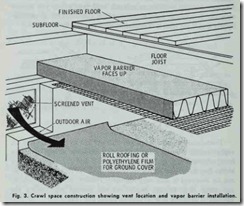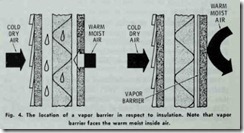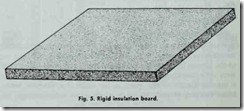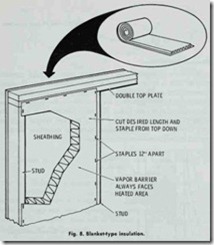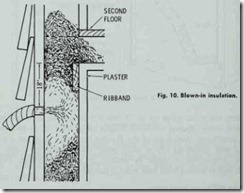CONDENSATION
Air will always contain a certain amount of moisture (water vapor), and the amount of moisture it contains will depend upon its temperature. Generally speaking, warm air is capable of con taining more moisture than cold air.
Air will lose moisture in the form of condensation when its temperature falls below its dew point. The dew point is the tem perature at which moisture begins to condense, in the form of tiny droplets or dew. Any reduction in temperature below the dew point will result in condensation of some of the water vapor present in the air.
The attic is one place where condensation often occurs. In the winter, the warm air from the occupied spaces leaks past the in sulation on the top floor ceiling and comes into contact with the cooler air in the attic. This causes the water vapor in the air to condense. The moisture resulting from condensation works its way down through the ceiling and walls, and eventually causes dam age to the insulation, wood, and other building materials.
The solution to condensation in the attic is twofold. Adequate ventilation should be provided in the attic to remove the humid air. This can be accomplished by installing louvers at each end of the attic or in roof overhangs to provide cross ventilation (Fig. 2). The louvers should have a total area of one square foot for each 300 square feet of attic floor space. For example, if the attic has an area of 900 square feet, the total louver area should be at least 3 square feet. In addition to suitable attic ventilation, you should also install a vapor barrier between the rafters. This is particu Iargely true if the attic is occupied or used extensively.
Foundation crawl spaces are also subject to condensation. A vapor barrier between the floor joists prevents excess moisture from accumulating, and causing dampness and eventually damage to the structure. Ventilating the crawl space so that the humid air can be removed is also very effective. Finally, placing an insulat ing paper (e.g. roofing paper) on the ground will reduce the amount of moisture that is released by the soil (Fig. 3).
Vapor Barriers
Insulation must be protected against moisture or it will lose its ability to reduce thermal transmission. An unprotected insu lation material will absorb moisture and lose its insulating value. This can be very expensive, because the insulation must be re placed completely. In most cases, there is no way to restore it to its original condition.
A vapor barrier is a nonabsorbent material (e.g. plastic, as phalt, metal foil, roofing paper, etc.) designed to protect insula tion from moisture or to prevent moisture from entering a space (Fig. 4). It can completely enclose the insulation or be applied to only one side. If the latter situation is the case, the vapor barrier must be installed so that it faces inward toward the heated rooms and spaces.
In addition to protecting insulation from absorbing moisture, a vapor barrier is also an effective means of retaining moisture
in the rooms and spaces in the structure, or preventing it from entering these areas. As a result, it functions as an important fac tor in maintaining interior humidity conditions.
If you add insulation over an existing vapor barrier, you should make a number of cuts in the barrier to avoid moisture entrapment. Remember: the name-of-the-game is dry insulation. Take whatever measure necessary to protect it from moisture.
TYPES OF INSULATING MATERIALS
Insulating materials are specifically designed to reduce the rate of heat transmission through ordinary construction materials to an acceptable level.
A dry material of low density is considered a good insulator;
however, in addition to this characteristic, it must also have a conductivity value of less than 0.5.
The conductivity value of a material is a purely arbitrary one determined by the amount of heat that flows through a one inch thickness of a material one square foot in area with the tempera ture exactly one degree Fahrenheit higher on one side of the ma terial than on the other.
Using the arbitrary conductivity value as a guide, the follow ing materials are regarded as providing the best insulation:
1. Expanded polyurethane (0.17),
2. Bats and blankets (0.27),
3. Mineral wool (0.27),
4. Corkboard (0.30),
5. Insulating board (0.33 ),
6. Expanded perlite fill (0.35),
7. Wood fibre sheathing (0.38),
8. Vermiculite (0.48).
Air spaces, or air spaces bounded by either ordinary building materials or aluminum foil, also provide some insulation, but not to the degree formerly thought. Dead air spaces in building walls were once considered capable of preventing heat transmission in a manner similar to the space in the walls of a thermos bottle. Later research proved this to be a somewhat false analogy, be cause the air in such spaces will often circulate and transmit heat by convection.
Air circulation can be checked by filling the hollow space
with an insulating material which contains a great number of small confined air spaces per unit volume. This stoppage of air circulation is what produces the insulating effect , and not neces sarily the existence of the air space. Under these circumstances, it is obvious that the most practical method of insulation is to fill the area in the walls with a material containing these minute air spaces.
A number of different manufacturers produce insulating materials in a variety of shapes and forms for installation in houses and other buildings. Frequently, instructions for the installation of their products will also be provided by the manufacturer. Local building supply outlets and lumber yards will often be very help ful, too, and will usually recommend the best way to install the insulation material. Some of these materials and their applications are described in the following paragraphs.
Insulating Board
Insulating board (Fig. 5) is a rigid or semi-rigid synthetic product commonly referred to as structural insulating board, rigid board , sheathing board, and produced under a variety of trade names. It is available in Y2 to 1 inch thicknesses, and in board sizes generally 4ft. by 8 ft.
Some insulating board is produced specifically for use on in terior walls. This type is generally made from wood fibers, and one side is prcfinished. Insulating board designed for use as structural insulation is produced from compressed fibrous materials other than wood and does not have a prefinished surface.
Slab Insulation
Rigid slab insulation is designed especially for application to flat roofs. The minimum thickness of slab insulation is 1 inch, with widths ranging up to 2 feet and lengths up to 4 feet. Foamed plastic or mineral wool impregnated with asphalt are used in the production of slab insulation, because they provide excellent protection against moisture.
Reflective Insulation
Reflective insulation (Fig. 6) is designed to reflect heat rather than resist its rate of flow. It is this characteristic that distin guishes it from other types of insulating materials. Aluminum foil is commonly used as the reflective surface, although coated papers have also been employed.
Air spaces must be provided on either side of a layer of re flective insulation. This type of insulating material has proven to be a good moisture barrier, and exhibits a high degree of resist ance to heat transmission.
Batt-Type Insulation
Batts (Fig. 7) are essentially smaller examples of blanket in sulation, ranging in thickness from 1 to 6 inches and available in 4 ft. and 8 ft. lengths.
The batts are manufactured with a vapor seal paper adhered to one face, covering the entire surface and extending 1Y2 inches on the long sides of the batt. These 1Y2 inch laps neatly folded against the membrane backing in manufacture, are turned out and tacked or stapled to the studs, rafters or joists in application. The paper backing helps to prevent the passage of vapor and resists the penetration of moisture from excess water in fresh plaster or other sources.
Blanket-Type Insulation
Blanket insulation (Fig. 8) is produced in the form of a con tinuous flexible strip, and is generally available in rolls or packs in the following three thicknesses: (1) thick (3 inch); (2) me dium ( 2 inch); and ( 3) thin (1 inch). Widths are commonly 15 inches, but wider strips up to 33 inches wide can be obtained on special order. Blanket insulation lengths range from 36 to 48 feet.
Sometimes both sides of the blanket insulation strip are cov ered with aluminum foil or plain paper which serves as a vapor seal. Application is made by tacking or stapling through 1 inch laps extending from both sides of the strip.
Loose Fill Type Insulation
Loose fill insulation (Fig. 9) is available in granular, fibrous, or powdered form, and is sold in bulk. (usually in bags). It is commonly produced from vermiculite or other granular materials, vegetable fibers, or mineral wools, and is especially suitable for pouring between floor joists.
Blown-In Insulation
B [own-in insulation (Fig. 10) is a loose fill type insulating material that is blown under pneumatic pressure into the spaces between joists and wall studs in an existing structure. Water vapor barriers are applied first, and are available in the form of a mois ture resistant spray-on paint. Blown-in insulation is most com monly used to insulate interior walls. Because special equipment must be used for its application, blown-in insulation should be applied by individuals trained in its use.
BUILDING CONSTRUCTION AND LOCATION
A new building (particularly a residence) should be located so that the large windows in the main rooms face south to receive the maximum sunlight during the winter months (Fig. 11). If possible, the building should be built in a location that offers some natural protection from the prevailing winter winds. Tight, well insulated construction should be incorporated in the design of the building from the very beginning. Although the initial costs will be somewhat higher, they will be effectively offset by the reduction in heating and cooling costs.
If a new heating or cooling system is planned for an older structure, the existing insulation should be checked, and, if nec essary, repaired or replaced before the new system is installed.
![fig.-2.-Two-methods-of-attic-ventila[2] fig.-2.-Two-methods-of-attic-ventila[2]](http://machineryequipmentonline.com/hvac-machinery/wp-content/uploads/2020/04/fig.-2.-Two-methods-of-attic-ventila2_thumb.jpg)
